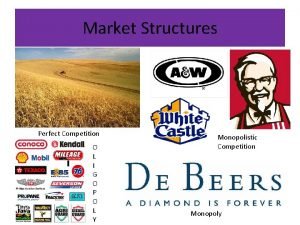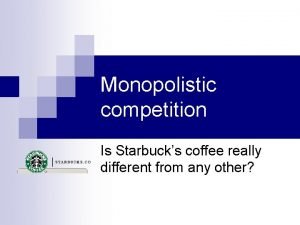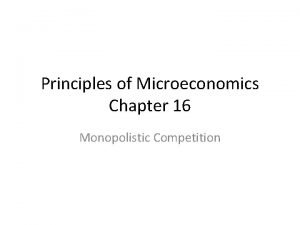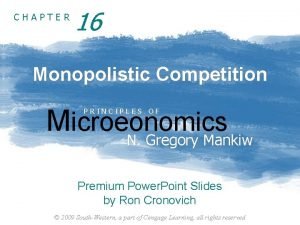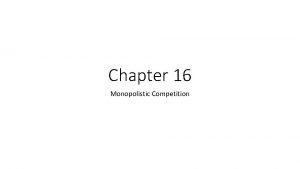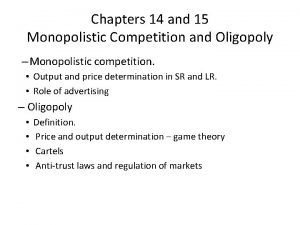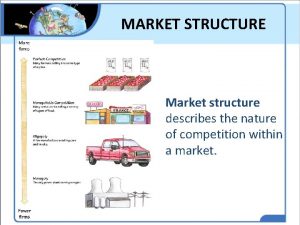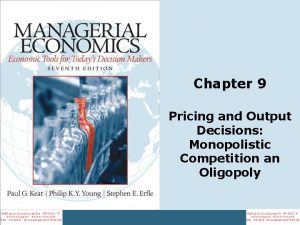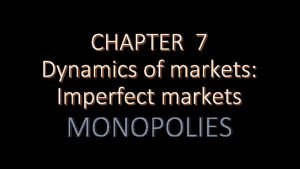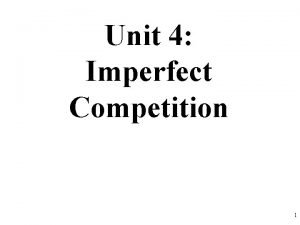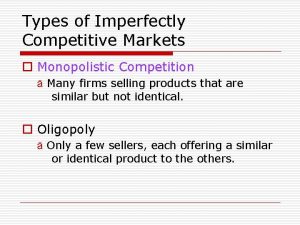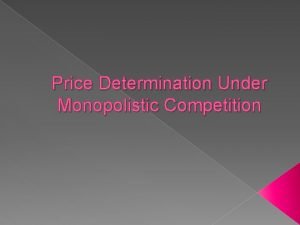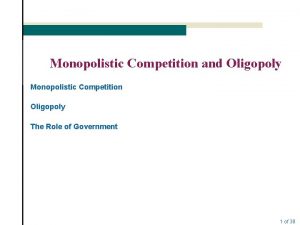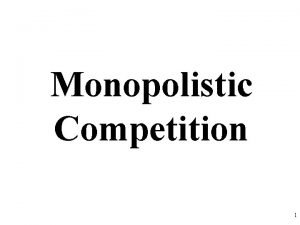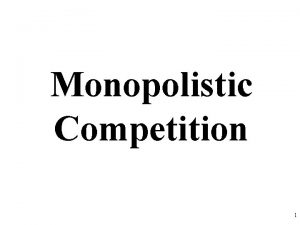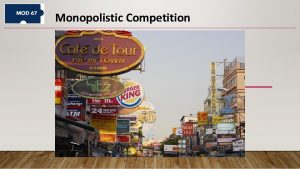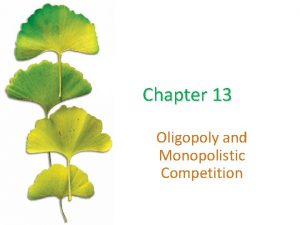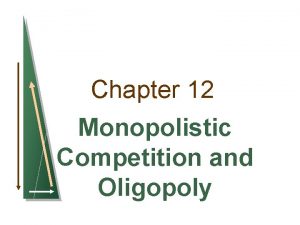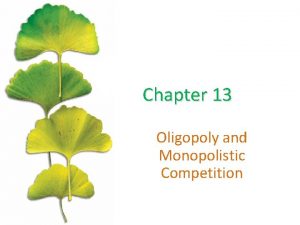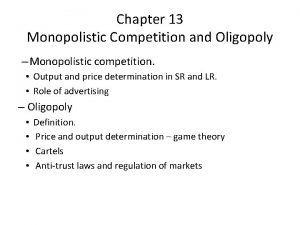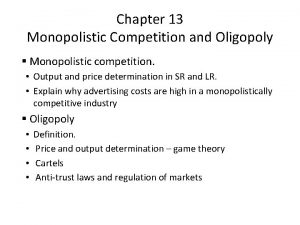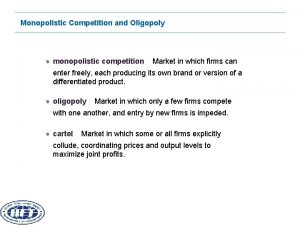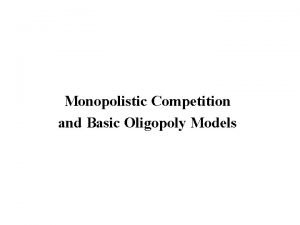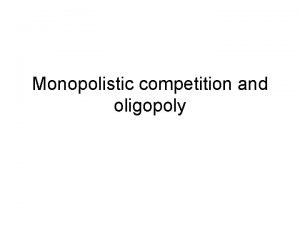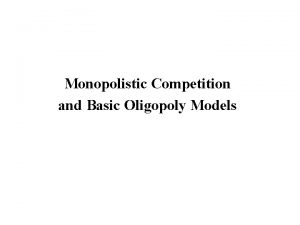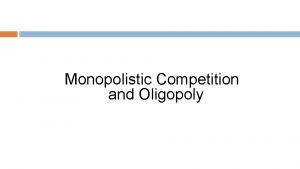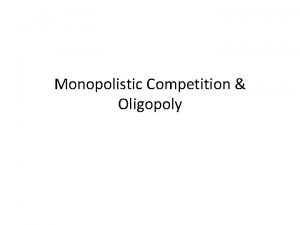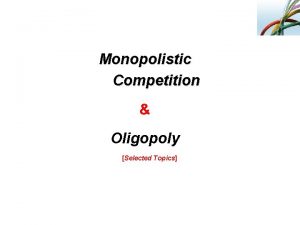CHAPTER 13 Monopolistic Competition and Oligopoly Monopolistic Competition




















- Slides: 20

CHAPTER 13 Monopolistic Competition and Oligopoly

Monopolistic Competition • Monopolistic competition • • LO 1 Relatively large number of sellers Product differentiation Easy entry and exit Nonprice competition like advertising 13 -2

Monopolistically Competitive Industries ■ Industry concentration ■ Measured by 4 -firm output concentration ratio of four largest ■ Percentage of sales by 4 largest firms total output in the 4 -firm CR industry ■=Herfindahl index ■ Sum of squared market shares LO 1 HI = (%S 1)2 + (%S 2)2 + (%S 3)2 + …. + (%Sn)2 13 -3

Price and Output in Monopolistic Competition ■ Demand is highly elastic ■ Short run profit or loss – Produce where MR = MC ■ Long run only a normal profit – Entry and exit LO 2 13 -4

Monopolistic Competition and Efficiency • Monopolistic competition inefficient • Productive inefficiency because P > min ATC • Allocative inefficiency because P > MC • LO 3 Excess capacity 13 -5

Product Variety ■ The firm constantly manages price, product, and advertising – Better product differentiation – Better advertising ■ The consumer benefits by greater array of choices and better products – Types and styles – Brands and quality LO 4 13 -6

Oligopoly • Oligopoly • A few large producers • Homogeneous oligopolystandardized • Differentiated oligopoly • Limited control over price • Entry barriers • Mergers LO 5 13 -7

Oligopolistic Industries • Four-firm concentration ratio • 40% or more to be an oligopoly LO 5 • Shortcomings • Localized markets • Interindustry competition • Import competition • Dominant firms 13 -8

Oligopoly Behavior • Oligopolies display strategic behavior • Mutual interdependence- depends on rival price and strategy • Collusion • Incentive to cheat • Game theory • Prisoner’s dilemma LO 6 13 -9

Game Theory Overview Rare. Air’s price strategy LO 6 High Uptown’s price strategy • 2 competitors • 2 price strategies • Each strategy has a payoff matrix • Greatest combined profit • Independent actions stimulate a response A $12 Low B $15 High $12 C $6 $6 D $8 Low $15 $8 13 -10

Game Theory Overview Rare. Air’s price strategy LO 6 High Uptown’s price strategy • Independently lowered prices in expectation of greater profit leads to worst combined outcome • Eventually low outcomes make firms return to higher prices. A $12 Low B $15 High $12 C $6 $6 D $8 Low $15 $8 13 -11

Three Oligopoly Models • Kinked-demand curve • Collusive pricing • Price leadership • Reasons for 3 models • Diversity of oligopolies • Complications of interdependence LO 7 13 -12

Kinked-Demand Theory ■ Noncollusive oligopoly ■ Uncertainty about rivals reactions – Rivals match any price change – Rivals ignore any price change ■ Assume combined strategy – Match price reductions – Ignore price increases LO 7 13 -13

Cartels and Other Collusion Price and costs MC ATC P 0 A 0 Economic profit MR=MC Q 0 LO 7 MR D Quantity 13 -14

Overt Collusion • A cartel is a group of firms or nations that collude • Formally agreeing to the price • Sets output levels for members LO 7 • Collusion is illegal in the United States • OPEC 13 -15

Obstacles to Collusion ■ Demand cost differences ■ Number of firms ■ Cheating ■ Recession ■ New entrants ■ Legal obstacles LO 7 13 -16

Price Leadership Model ■ Price leadership – Dominant firm initiates price changes – Other firms follow the leader ■ Use limit pricing to block entry of new firms ■ Possible price war LO 7 13 -17

Oligopoly and Advertising ■ Oligopolies commonly compete though product development and advertising – Less easily duplicated than a price change – Financially able to advertise LO 8 13 -18

Positive Effects of Advertising ■ Low-cost way of providing information to consumers ■ Enhances competition ■ Speeds up technological progress ■ Can help firms obtain economies of scale LO 8 13 -19

Oligopoly and Efficiency ■ Oligopolies are inefficient – Productively inefficient because P > min ATC – Allocatively inefficient because P > MC ■ Qualifications – Increased foreign competition – Limit pricing – Technological advance LO 9 13 -20
 Chapter 7 section 3 monopolistic competition and oligopoly
Chapter 7 section 3 monopolistic competition and oligopoly Difference between monopoly and perfect competition
Difference between monopoly and perfect competition Is the coffee market perfectly competitive
Is the coffee market perfectly competitive Characteristics of an oligopoly
Characteristics of an oligopoly Characteristic of monopoly
Characteristic of monopoly Monopoly vs monopolistic competition
Monopoly vs monopolistic competition Pure competition vs monopolistic competition venn diagram
Pure competition vs monopolistic competition venn diagram Competition refers to
Competition refers to Chapter 16 monopolistic competition
Chapter 16 monopolistic competition Characteristics of monopolistic competition
Characteristics of monopolistic competition Monopolistic competition long run
Monopolistic competition long run Barriers of entry for oligopoly
Barriers of entry for oligopoly Non price competition in oligopoly
Non price competition in oligopoly Monopolistic competition pictures
Monopolistic competition pictures Perfect competition disadvantages
Perfect competition disadvantages Example of pure competition
Example of pure competition Difference between monopoly and perfect competition
Difference between monopoly and perfect competition Advantages and disadvantages of monopolistic competition
Advantages and disadvantages of monopolistic competition Excess capacity on a graph
Excess capacity on a graph Monopolistic competition products examples
Monopolistic competition products examples Price determination under monopolistic competition
Price determination under monopolistic competition

